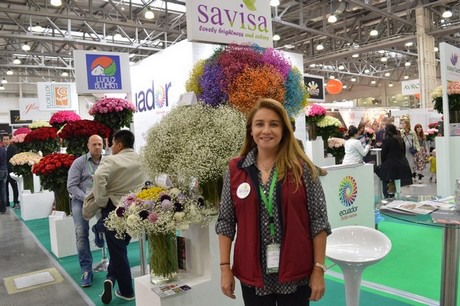
Maria Fernanda Jimenez at the FlowersExpo 2017 in Moscow, Russia.
Snowball and Mirabella
Mirabella and Snowball are bred by BallSB and have the same blood, the only difference is the size of the head of the flower. "Mirabella is a medium sized gypsophila and Snowball a large sized gypsophila", says Maria Fernanda Jimenez of Savisa. "They both have a bright white color, are easy to tint, have a thick stem that prevent the flower from falling over and a good vase life of about 20 to 25 days." On their farm in El Quinche, located at 2,484 meters above sea level, they grow Mirabella on 8 ha and Snowball on 6. The rest of the area is used for the cultivation of their small sized gypsophila Vivo and some craspedia and delphinium.
Sustainability
Being as environmentally friendly as possible is important to Savisa and both varieties fit in very well as they have been bred with sustainability in mind. "They do not require any additional lightning", says Lourdes Reyes of BallSB. "And they are more resistant to leaf miners, which results in less usage of crop protection products. All in all, this results in a more environmentally friendly product", says Jimenez. The sustainable story that comes with these varieties is valued by Savisa's customers. "They do not only like the flower itself, but the environmental story behind it seems to become increasingly important too."

Lourdes Reyes and Maria Fernanda Jimenez with Ball's Best Display Design award at the FlowersExpo Moscow. The booth of Ball was decorated with Snowball, grown by Savisa.
Reactions to Snowball
Last year, Savisa started to plant Snowball on 6 ha of the farm, and the reactions to this new variety are very positive. "Russians, for example, are fond of bright white and large headed gypsophilas; the sales of this variety in this market are doing well." Besides that, tintability of the gypsophila is also becoming more important. "In China and increasingly in the USA, tinted gypsophilas are highly demanded. And this is the other reason why we've chosen to grow Snowball because it is very suited to be tinted, as the color is being absorbed all over the flower and the durability is amazing"
For more information
Savisa
Maria Fernanda Jimenez
Emaill: [email protected]
www.savisa.com
